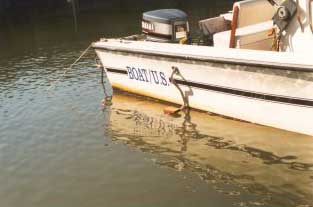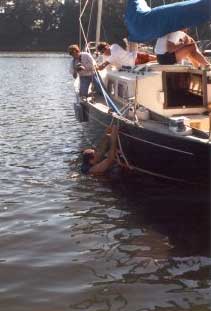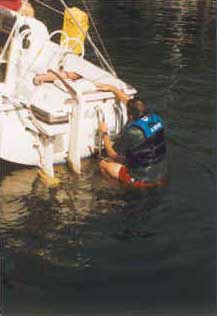Boarding Ladders — Step Class for the Non-Aerobic
Foundation Findings #24 - March 1996
View our 2008 Study HereYou are out alone delighting in a beautiful day on the water.
Suddenly, the engine quits. Belatedly, you realize you've entered a field of crab pots and one of the float-lines may have fouled your drive system. There's only one way to find out if the cable is wrapped around your drive shaft or propeller. First you remove the key from the ignition, making sure your engine is completely shut off. Then you go over the side and under the water to check. After struggling to untangle the mess - because, as Murphy's Law says, if something can go wrong it will go wrong, and at the worst possible moment - getting back on board could be much easier if your boat is equipped with a good boarding ladder or other device.
More importantly, a ladder can make retrieving a crew member who has fallen overboard easier. And a boarding ladder, with or without a platform, adds to the enjoyment of a pleasant swim in your favorite gunk-hole, by allowing easier access to the water.
Boarding Ladders | ||||||||
| Price & Features | Emergency Rope w/plastic steps | Portable 3-step, sailboat | Portable 3-step, powerboat | Portable 4-step, sailboat | Portable 4-step, powerboat | Mini-swim platform, 2-step | Removable & folding, transom mount | Removable, transom mount boarding bar |
| Discounted Price (avg) | $22.95 | $26.95 | $33.50 | $135.00 | $129.00 | $67.50 | ||
| Lowest Step's Depth Below Waterline | 20'' | 6'' | 10'' | 14'' | 20'' | 18'' | 16'' | 10'' |
| Seconds to board (four-member-team average) | 22.3 (test finished by only 3 subjects) | 10.35 | 9.18 | 9.39 | 8.59 | 6.665 | 4.76 | 12.045 (skewed by one subject's time of 23.96 seconds) |
| Ease of entering water | poor | fair | fair | good | good | good | excellent | fair |
| Ease of exiting water in to boat | poor | fair | fair | good | good | good | excellent | fair |
| Step Comfort | poor | fair | fair | fair | fair | good | good | good |
In Water Ladder Tests
Last fall, the Foundation for Boating Safety conducted an in-water test to evaluate the efficiency and comfort of various boarding devices available through most boating equipment stores and catalogs. We wanted to find out what features of the various various types of ladders and platforms contribute to the ease or difficulty of putting them to their intended use. We discovered that some definitely gave better support and were easier to to use than others. We conducted the boarding tests on a quite creek where wind, weather, and water conditions were near optimum, so factors other than ease of ladder use would be minimized.
For the tests, we chose four subjects with different physical characteristics and whose weight ranged form about 140 pounds to approximately 225 pounds. Participants included one woman in her late 20's, who exercises sometimes, but not on a regular basis, and three men: an athletic 24-year old who works out three times a week; a fairly active 50-year old who does not exercise regularly; and one man in his late-fifties, who exercises only in spurts.

We wanted to evaluate a representative sampling of units which are likely to be used on recreational boats - both power and sail. The staff selected ladders and a platform that were readily available in the recreational boating marketplace. All the ladders tested were compact enough to store easily aboard most types of vessels. None float.
The mini-swim platform we used was fixed. During the tests we were careful to follow basic safety procedures, including wearing personal floatation devices by those testing the boarding devices. We also shut off boat engines completely, not just letting them idle, whenever anyone was in the water near the boat, to avoid the danger of cuts from the propeller.
Current American Boat and Yacht Council (ABYC) guidelines call for all manufacturer-installed boat boarding devices to be capable of withstanding a vertical downward static load of 400 pounds without permanent deformation in excess of 1/4 inch. They also specify that, if a ladder or other step-like device is used as the means for boarding, the first step shall be at least 10 inches below the waterline. ABYC is currently reviewing boat safety features including boarding ladder specifications, such as proper depth of immersion for the lowest rung and the most effective placement of hand holds for reboarding, under a U.S. Coast Guard grant scheduled to be completed this spring.
Boarding Ladder Ratings
The Foundation Team evaluated the various ladders based on how well they worked on the three boats on which we tested them; a 23-foot sloop with 16 inches of freeboard at the transom; a 31-foot auxiliary sloop with 36 inches of freeboard where the ladders were placed; and a 22-foot center console with 17 inches of freeboard. The devices may perform better or worse when used on boats with different freeboard and hull configurations. Units we tested, along with manufacturer’s suggested weight-bearing capacities, are as follows:
Emergency Boarding Ladder

Designed to be secured to cleats, stanchions and halyards for emergency use, this ladder features five orange-colored plastic rungs connected by nylon rope, fed through plastic tubing to separate the steps that unfold up to a six-foot depth or fold for storage to six inches. Non-skid steps are curved, like thick, venetian-blind slats. First step depth during our test was 20 inches below the waterline, but may vary depending on your boat’s freeboard. Different models offer 300- and 450-pound weight capacity. This device is not well suited for emergency use, unless techniques for mounting the lowest, underwater step of the devices are learned and practiced. Even on a calm creek with ideal weather and water conditions it was extremely difficult to use. Because it is not at all rigid, when trying to get a foothold on the lowest, underwater rung it tends to swing up under the boat, often jamming the user’s toes between the ladder and the boat’s bottom.
Additionally, all participants said their hands and feet slipped on the rungs. One subject said the steps tended to slant to one side, causing slippage, and that the lower slat edges were quite sharp. Another caught his finger under the rope while grasping the boat, as he tried to get enough leverage to pull himself over the side. A third subject struggled to board this ladder and finally had to abandon the effort after more than two minutes because it offered no support. She lacked the upper body strength to wrestle her way to a standing position on the bottom rung and her arms were too short to reach above the boat’s smooth side to grasp the gunwale, as the men had. In the context of these tests, conducted on these vessels, the Foundation team rated this ladder’s performance poor.
Hood-Style Portable Ladders
Designed to be stored until needed, three-and four-step models are constructed of 1-inch diameter aluminum tubing with non-slip, plastic-grid steps. They offer 11-inch and 7-inch, vinyl-covered, cushion-tipped rail hooks for wide or narrow gunwales and movable, soft-tipped, aluminum standoffs which won’t scratch boat hulls. Standoffs, short legs designed to hold the ladder away from the boat’s stern or side, and hooks fold for compact storage. These ladders, we were surprised to learn, are weight-rated at only about 175 pounds-185, tops, according to the manufacturer. Weight-bearing capacity is neither mentioned on the shipping carton for these best-selling units nor in the accompanying literature.
We tested three-step and four-step ladders with 11-inch rail hooks on both a sailboat transom and the wider gunwale of a power boat. The hooks slipped on the narrower transom as they settled into place, startling the testers and making the ladders more difficult to mount.
Additionally, the vinyl covering on one unit’s hooks tore as it slipped because the 11-inch hooks were too large for the sailboat’s narrow transom. This incident points up the need to check to see if a smaller, seven-inch hook model would fit better on your boat. The folding standoffs were unsteady and collapsed on several occasions during the tests, even when the tester was under the 185-pound manufacturer’s maximum weight recommendation. Testers weighing 200 pounds or more found the standoffs to be extremely unstable, which caused them to collapse, resulting in jammed toes.
All evaluators agreed these ladders were significantly easier to use when hung over the motorboat gunwale than when hung from the sailboat’s transom because, due to the powerboat’s lower freeboard, they were more stable and their bottom steps were deeper in the water. They also found that the fourth step made entering and leaving the water much easier. All agreed the plastic step grids were hard, almost painful, on the feet and evaluated the ladders fair under the test conditions and on the boats mentioned above.
Mini-Swim Platform
This unit includes a permanently fixed, teak platform and 1-inch stainless steel steps with teak treads. Weight capacity figures are not available because weight bearing tests have never been run, the manufacturer says.
The team set out to test two mini-swim platforms; one with two steps, the other with only one. Because the step of the one-step platform was so close to the surface that it was about as easy to board the boat without it, we all agreed it was unsatisfactory and dropped it from the test. All gave positive marks to the two-step platform, and one participant chalked up her best boarding time on this unit. The 18-inch depth of the platform’s bottom step contributed greatly to the ease of boarding. This unit was awarded a good to excellent rating by the team.
Transom Ladder, Removable Mount
Also rated good to excellent, this ladder features 1-inch diameter stainless steel tubing and has two fixed steps and two that fold up for easy stowage and to avoid dragging in the water when underway. Flattened, contoured treads feature a non-skid finish, and two slide-in keyhole mounting brackets provide a secure fit and easy removal. Also available in a permanent-mount version, these ladders support up to 308.6 pounds with some flex, full recovery and nil deformation, according to the manufacturer.
This ladder received more excellent ratings than any other. One staffer called it excellent with good comfort and said it was definitely the easiest to use. Another found it superb when climbing aboard the boat and very easy to use when entering the water. All agree it was the best of all the ladders tested, and three of the four subjects had their fastest boarding times using this unit.

Removable Boarding Bar
Also bracket mounted, this unusually shaped ladder is constructed from 1-inch stainless steel tubing with two teak steps. This unit worked fairly well when attached to the side of the boat we used for the tests. It is said to be capable of supporting 300 pounds.
One subject found the bottom step to be higher and less stable than anticipated, forcing him to steady the first step with both knees to carefully gain his balance before placing weight on the ladder. The two other men had mixed reactions: one, like the first subject, found the first step to be somewhat unstable and hard to mount; the other liked this device as well as any of those tested The female Team member, who had problems with the slat and rope ladder, liked this unit quite well. It was given a fair to good rating under the test conditions mentioned above.
Conclusions
The most valuable lesson we learned from our tests is that, whatever boarding device is used, it is important to familiarize yourself with how the unit works and to practice before an emergency occurs. Properly attach the device to your boat, then try it out! These results mirror the need to practice reboarding techniques that was discovered several years ago when the Foundation did crew overboard tests (Reports, January 1993). For all our test subjects, rigid ladders proved superior to the more flexible, rope ladder when reboarding a boat. That rigidity permits the user to board more easily because it provides better leverage and stability, allowing for better handhold and foothold coordination. This conclusion would seem to be borne out by early results of the tests being conducted by ABYC. Those tests appear to show that handhold location is as important a consideration as any other when attempting to reboard a boat, according to an ABYC spokesman.
These ladders may be purchased through West Marine and other marine equipment retailers.

